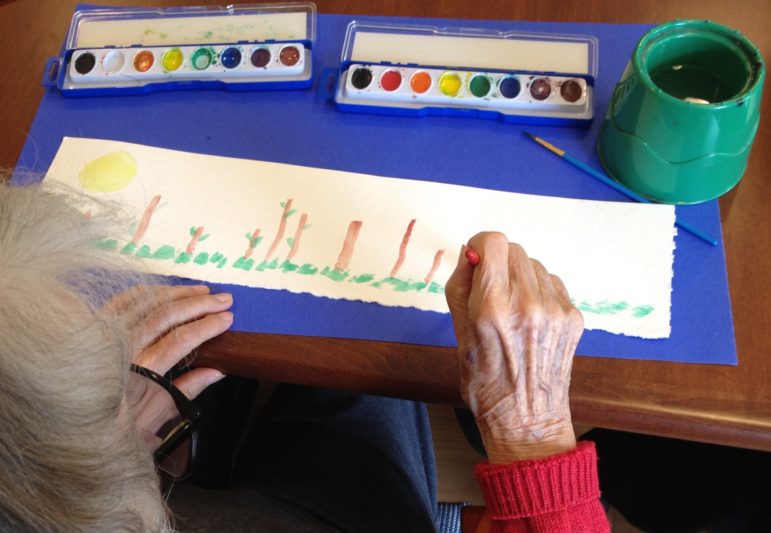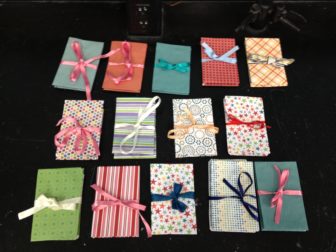
Emery Mikel
Art therapy has been shown to help patients express feelings and address anxieties when traditional counseling didn't help.
Miriam Stirewalt didn’t know much about art therapy before entering the eating disorder treatment program at the Renfrew Center of New York. At Renfrew, Stirewalt participated in a group led by a creative arts therapist. These sessions, she says, gave her a voice.
“It gave me an opportunity to express things I couldn’t convey using words,” Stirewalt says. “It helped me face issues that I felt frightened and anxious about dealing with.”
One of the issues Stirewalt found difficult to confront was losing several people in her life to suicide within the past few years. She says, “It’s something I couldn’t talk about. I made a collage at Renfrew and was able to start a conversation with my therapist.”
Stirewalt is one of many experiencing the benefits of art therapy. As Drena Fagen, an art therapist and clinical social worker at New York Creative Arts Therapists, explained, art therapy “uses creativity and art to uncover what’s making one distressed as well as providing coping skills.”
Insurance limitations create barriers

Emery Mikel
Despite the positive influence art therapy brings for many, not everyone has access to it. Those who have access to the therapy through treatment programs or hospitals often lose the opportunity to benefit from art therapy once they leave and need outpatient help.
After being discharged from the Renfrew Center, Stirewalt searched for an art therapist who takes her insurance, but was unable to find anyone. She also had trouble finding art supplies once she left Renfrew. Still, Stirewalt has managed to continue making art regularly, often with magazine clippings. She says it helps her understand her thoughts and feelings better.
“If I could afford formal art therapy, I would do it. I do it on my own because I don’t have access to that,” Stirewalt says.
Her lack of formal art therapy means that she cannot make art with the guidance of an art therapist. In turn, she loses the opportunity to talk through the significance of the artwork with a mental health professional.
Stirewalt is not alone in wanting more art therapy than she can afford. Emery Mikel, founder of Water & Stone Creative Arts Therapy, says, “I’ve heard that from friends as a common problem when people who are in a program that has art therapy and then they leave and look for it and can’t take advantage of it anymore. It’s too bad because it would be great if they could continue with that.”

Art Therapy Outreach Center
Access to art therapy is even more limited for people without insurance. To change this, the Art Therapy Outreach Center provides art therapy at no cost to underserved populations, including at-risk youth, survivors of trauma and homeless veterans. According to Executive Director Martha Dorn, they served 1,110 people last year and approximately 95 percent of these clients are considered low income.
“Without us, underserved populations wouldn’t have access to art therapy. We are the only organization in New York that solely provides art therapy at no cost,” Dorn says.
New Yorkers wait for help
After the Art Therapy Outreach Center started a new program providing art therapy to female veterans, there have been people on the waitlist for a year.
“It pains me to say no to people,” Dorn says.
Waitlists are not uncommon in art therapy. Fagen says she cannot meet the demand from New Yorkers and has a waitlist for her private practice in Brooklyn.
“There is a demand, but there are barriers to getting people access to it. If you’re ready to say ‘Deal with depression and [if] you hit a wall, you may go back to your dark hole,’ That should not be allowed to happen,” Fagen says.

Emery Mikel
Although Mikel does not take insurance yet because her private practice is relatively new and she wants to get the company going first, she offers a sliding scale and keeps slots open for “low fee clients.” These openings are reserved for people who can’t afford her sliding scale that ranges from $100 to $180 for individuals. Even the cost of group therapy is usually in between $50 and $75 per hour depending on factors such as the type and size of the group. Some of Mikel’s clients have needed only a couple of months of art therapy, but others come for a few years.
Mikel, though, can take only two people as “low fee clients” at a time because payments of $30 to $50 per session cannot sustain her business.
As Fagen put it, “Based on the demand of people calling every day, we know there are New Yorkers seeking us out and can’t get access to art therapy.”
Impact of New York State regulations
Mikel has practiced art therapy in several locations in the United States including Washington D.C., Maryland and Colorado. She has noticed, from her own experience and speaking with colleagues, that individuals who are trained as art therapists in New York tend to leave the state in order to find jobs. From Mikel’s observations, this is due in large part to regulations in New York State that apply to art therapy.

Art Therapy Outreach Center
Individuals who want to practice art therapy in New York must be registered by the Art Therapy Credentials Board and be granted the LCAT (Licensed Creative Art Therapist) license by the state. Mikel says that the problem lies in New York’s requirements for the LCAT license.
“A lot of states are giving licenses now, which is awesome. But, New York has very strict rules around what you have to do to get your license once you graduate, which include an approved site, an approved supervisor at that site,” she says. “This is fine except that there aren’t as many jobs out there so people coming out of school tend to leave the state.”
According to Mikel, many of the art therapists who stay in New York “tend to say, ‘I can’t work here’ or struggle so long that they give up and don’t do art therapy anymore.”
Mikel had options for where to work after graduating from Naropa University’s art therapy program in Boulder, Colorado. In Colorado, however, Mikel was able to have an approved supervisor off site.

Art Therapy Outreach Center
As stated on the New York State Office of Professions website, “the supervisor must be your employer, or be employed in the same agency.” This policy, in effect, limits the accredited placements available for new graduates in New York.
Mikel says, “It’s good to have the guidelines, but how they’re done, it’s a bit stifling right now.”
Well-intended regulation put in place by New York State to improve the quality of mental health care has led to yet another limitation on the access to art therapy. Not only does insurance coverage restrict how many people can afford art therapy, but these regulations also limit how many people are out there to provide it.
NY health plans don’t always accept the license
When Mikel used to visit her grandmother with Alzheimer’s disease at a facility, she brought art supplies. Soon enough, others in the room gravitated toward their table. These visits with her grandmother and the reaction of fellow residents became the inspiration for Mikel to pursue art therapy as a career.
“I realized there was something there. Especially as some of them became less verbal, they could still express themselves,” she says.

Art Therapy Outreach Center
How do you put a price tag on giving someone a voice? This is the job of insurance companies.
Beacon Health Options, formerly ValueOptions, processes mental health claims for many health plans in New York City including GHI, Emblem, Oscar and Medicare. While the LCAT license has been the standard requirement by New York State for people to practice any kind of creative arts therapy since 2005, Beacon Health just started accepting LCAT certified art therapists as in-network providers this March.
Still, insurers can choose what disciplines and services are covered under their benefit plans, according to Amy Sheyer, Assistant Vice President, External Relations at Beacon Health Options.
“So even if they are in network with us, they may not be covered under certain plans,” Sheyer says.
To be accepted as in-network providers, art therapists often have to obtain other credentials in fields such as social work.
Healthfirst and Cigna were the only two health plans in New York that took the LCAT license for in-network providers up until March. For adults on Medicaid in New York, art therapy is not covered. Starting in July 2017, children will have access to art therapy under Medicaid.

Emery MIkel
“I think one of the amazing things about New York is that they have the license for creative arts therapists and it’s wonderful that they recognize us as a profession,” Mikel says. “I think the downside is the insurance companies in New York do not always agree, or recognize us in the same way.”
One client at the Art Therapy Outreach Center created a collage where, amidst the images, there’s a cut out with the question, “NOW WHAT?” The professionals themselves will have to answer this question before art therapy will be accessible for all New Yorkers who need it.
City Limits’ coverage of art and art policy is supported by the Laurie M. Tisch Illumination Fund.









3 thoughts on “Art Therapy Helps, But Insurance Often Hinders It”
Thank you Nicole for this coverage. The problem for LCATs has become very much worse since tough restrictions were put on our ability to take normal mental health classes to earn CEUs to get or maintain licensure. Please contact me if you would be interested in doing follow up investigation of NYS policy and laws that are curtailing the availability of art therapy now and in the future. Sincerely,
Patricia Quinn MS, ATR-BC, LCAT
Governmental Affairs Chair, NYATA
Patricia,
A close friend of mine wants to do private practice as an LCAT in NYS. any advice and knowledge you wish to share would be greatly appreciated. You may contact me at mjmiller@oswegohealth.org
As an art therapy provider, I share your feelings about the lack of insurance coverage despite the obvious need for services. Thanks for giving info on the insurance plans that cover art therapy – I have been researching this question and your article seems to be the only source that gives a clear answer. Thank you!